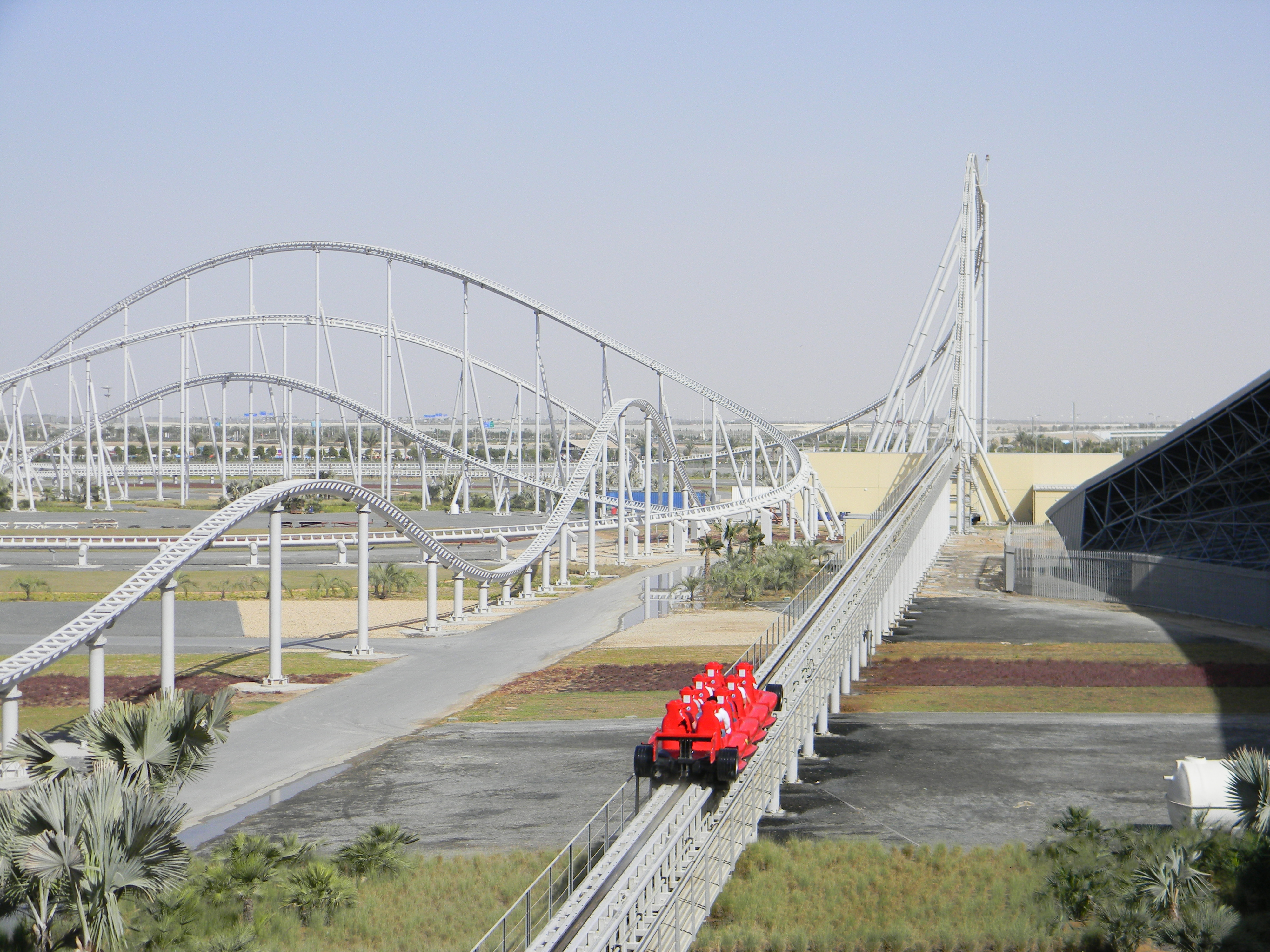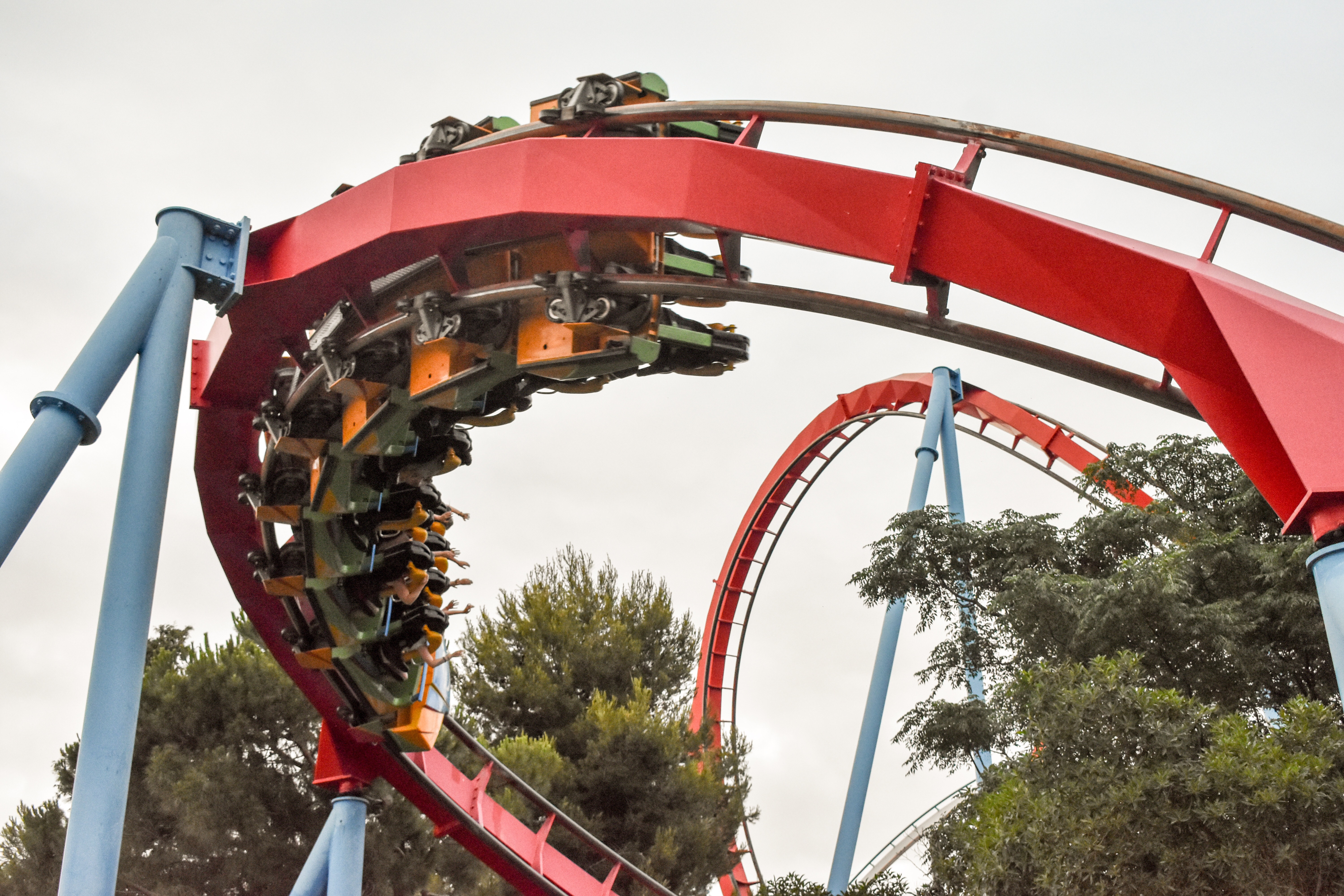|
Typhoon (Bobbejaanland)
Typhoon is a steel roller coaster at the Bobbejaanland amusement park in Lichtaart, Belgium. Typhoon is a Gerstlauer Euro-Fighter model roller coaster, and the second installation of this model line. At 97 degrees, the coaster's first drop is steeper-than-vertical and it has the steepest drop of any roller coaster in Belgium. History Constructed by the German roller coaster manufacturer Gerstlauer, Typhoon opened on 10 April 2004 and was built to replace the Looping Star roller coaster at Bobbejaanland. Typhoon was the most popular roller coaster in the park as of 2010. Layout and ride experience Typhoon is a relatively compact roller coaster with a base of by with a maximum height of almost , which has been cited as being particularly small for a roller coaster with the number of inversions that Typhoon has. The Typhoon has four inversions: a vertical loop, double heartline roll Roller coaster elements are the individual parts of roller coaster design and operation, suc ... [...More Info...] [...Related Items...] OR: [Wikipedia] [Google] [Baidu] |
Werner Stengel
Werner Stengel (born 22 August 1936, in Bochum) is a German roller coaster designer and engineer. Stengel is the founder of Stengel Engineering, also known as Ingenieurbüro Stengel GmbH (or Ingenieurbuero Stengel GmbH). Stengel first worked on amusement park rides in collaboration with Anton Schwarzkopf in 1963. He established his own company, Stengel Engineering, in 1965. His collaboration with Schwarzkopf was responsible for many innovations in roller coaster design, including in 1976 the first modern "vertical" looping coaster, ''Revolution'', at Six Flags Magic Mountain. ( Arrow Dynamics had debuted the first modern inversion, the corkscrew, a year earlier at Knott's Berry Farm). His clothoid loop is now standard on many roller coasters, as it produces less intense forces on the human body than a circular vertical loop. In 1976 Stengel and Schwarzkopf established the first horizontal launch "Shuttle Loop". He was a pioneer in heartlining, the principle of having the track ... [...More Info...] [...Related Items...] OR: [Wikipedia] [Google] [Baidu] |
Lift Hill
A lift hill, or chain hill, is an upward-sloping section of track on a roller coaster on which the roller coaster train is mechanically lifted to an elevated point or peak in the track. Upon reaching the peak, the train is then propelled from the peak by gravity and is usually allowed to coast throughout the rest of the roller coaster ride's circuit on its own momentum, including most or all of the remaining uphill sections. The initial upward-sloping section of a roller coaster track is usually a lift hill, as the train typically begins a ride with little speed, though some coasters have raised stations that permit an initial drop without a lift hill. Although uncommon, some tracks also contain multiple lift hills. Lift hills usually propel the train to the top of the ride via one of two methods: a chain lift involving a long, continuous chain which trains hook on to and are carried to the top; or a drive tire system in which multiple motorized tires (known as friction wheels) ... [...More Info...] [...Related Items...] OR: [Wikipedia] [Google] [Baidu] |
Steel Roller Coaster
A steel roller coaster is a roller coaster that is defined by having a track made of steel. Steel coasters have earned immense popularity in the past 50 years throughout the world. Incorporating tubular steel track and polyurethane-coated wheels, the steel roller coasters can provide a taller, smoother, and faster ride with more inversions than a traditional wooden roller coaster. Arrow Dynamics first introduced the steel roller coaster to feature tubular track to the thrill industry with their creations of the Matterhorn Bobsleds (Disneyland) in 1959 and the Runaway Mine Train (Six Flags Over Texas) in 1966. As of 2006, the oldest operating steel roller coaster in North America is Little Dipper at Memphis Kiddie Park in Brooklyn, Ohio and has been operating since April 1952. The oldest operating steel rollercoaster in the world is Montaña Suiza at Parque de Atracciones Monte Igueldo (Spain). It has been operating since 1928. Characteristics *Steel coasters have a general ... [...More Info...] [...Related Items...] OR: [Wikipedia] [Google] [Baidu] |
Bobbejaanland
Bobbejaanland is a theme park in Lichtaart, Belgium. The park was founded by Bobbejaan Schoepen, a Flemish singer, guitarist, and entertainer who enjoyed international success in the fifties and early sixties. In 1959, he bought a 30 hectare marsh, had it drained and built a 1,000 capacity venue that opened in December 1961 as Bobbejaanland. This developed into an amusement park and remained in his possession until he sold it in 2004. History For its first decade after opening the park centered on water attractions and performance spaces. Numerous variety artists from Belgium, the Netherlands and Germany appeared there. Following the advice of Phantasialand owner Gottlieb Löffelhard, Bobbejaanland evolved from 1975 onwards into a theme park, with rides becoming more important than music shows. It grew to fifty attractions with four hundred employees and received visitors from the Benelux countries, France, and Germany. As an independent family concern, it also supported educat ... [...More Info...] [...Related Items...] OR: [Wikipedia] [Google] [Baidu] |
Lichtaart
Lichtaart is a village in Belgium, in the province of Antwerp and municipality of Kasterlee. The village is situated near the town, Antwerp. Lichtaart bordered by the Rivers, Nete and Kaliebeek. In 1977, Lichtaart had an area of 25 km ² and had 4229 inhabitants. Lichtaart is notable for the theme park, Bobbejaanland and the folk singer, Bobbejaan Schoepen. Demographics Growth of population Landmarks *The neo-Romanesque church (1864) in the village has a large, gothic tower (16th century) and a bell housing from the 17th century. * Bobbejaanland, Theme Park Famous residents * Bobbejaan Schoepen Bobbejaan Schoepen (a pseudonym of Modest Schoepen; 16 May 1925 – 17 May 2010) was a Flemish pioneer in Belgian pop music, vaudeville, and European country music. Schoepen was a versatile entertainer, entrepreneur, singer-songwriter, guita ... * Louis Croenen References {{Authority control Populated places in Antwerp Province Kasterlee ... [...More Info...] [...Related Items...] OR: [Wikipedia] [Google] [Baidu] |
Gerstlauer Euro-Fighter
The Euro-Fighter is a type of steel roller coaster developed by Gerstlauer. First launched in 2003, the trademark feature of the roller coaster is its beyond-vertical drop, which reaches an angle greater than 90 degrees. Although the majority of Euro-Fighters are custom designed for each installation, every design so far has included the trademark drop. A number of different track elements are possible, including vertical loops, diving loops and barrel rolls. Almost all Euro-Fighter models have a vertical chain-driven lift hill, although LSM launch systems are also available. Riders are transported in individual cars around the track, which feature two rows of four seats. Two exceptions are ''Huracan'' at the Belantis amusement park in Germany and ''Dare Devil Dive'' at Six Flags Over Georgia, which both feature cars similar to those used on Gerstlauer's launched roller coasters. The cars have over-the-shoulder restraints and may be themed (to an extent) according to the custome ... [...More Info...] [...Related Items...] OR: [Wikipedia] [Google] [Baidu] |
List Of Roller Coaster Rankings
Roller coasters are amusement rides developed for amusement parks and modern theme parks. Early iterations during the 16th and 17th centuries, which were popular in Russia, were wooden sleds that took riders down large slides made from ice. The first roller coasters that attached a train to a wooden track appeared in France in the early 1800s. Although wooden roller coasters are still being produced, steel roller coasters, introduced in the mid-20th-century, became more common and can be found on every continent except Antarctica. Amusement parks often compete to build the tallest, fastest, and longest rides to attract thrill seekers and boost overall park attendance. Ranked by height, speed, length, and number of inversions, roller coasters often became the focal point for competing parks. Computer-simulated models led to new innovations that produced more intense thrills while improving quality and durability. The debut of Magnum XL-200 in 1989 at Cedar Point introduced the fi ... [...More Info...] [...Related Items...] OR: [Wikipedia] [Google] [Baidu] |
Looping Star (Bobbejaanland)
{{Disambiguation ...
Looping Star is the name of several roller coasters: *Looping Star (Codona's Amusement Park) *Looping Star (Nagashima Spa Land) Looping Star is a steel roller coaster located at Nagashima Spa Land in Mie, Japan. It is a Looping Star model built by Anton Schwarzkopf in 1982, two years after the park’s Shuttle Loop roller coaster was built. The trains on Looping Star u ... [...More Info...] [...Related Items...] OR: [Wikipedia] [Google] [Baidu] |
Vertical Loop
The generic roller coaster vertical loop, where a section of track causes the riders to complete a 360 degree turn, is the most basic of roller coaster inversions. At the top of the loop, riders are completely inverted. History The vertical loop is not a recent roller coaster innovation. Its origins can be traced back to the 1850s when '' centrifugal railways'' were built in France and Great Britain. The rides relied on centrifugal forces to hold the car in the loop. One early looping coaster was shut down after an accident. Later attempts to build a looping roller coaster were carried out during the late 19th century with the '' Flip Flap Railway'' at Sea Lion Park. The ride was designed with a completely circular loop (rather than the teardrop shape used by many modern looping roller coasters), and caused neck injuries due to the intense G-forces pulled with the tight radius of the loop. The next attempt at building a looping roller coaster was in 1901 when Edwin Prescott b ... [...More Info...] [...Related Items...] OR: [Wikipedia] [Google] [Baidu] |
Heartline Roll
Roller coaster elements are the individual parts of roller coaster design and operation, such as a track, hill, loop, or turn. Variations in normal track movement that add thrill or excitement to the ride are often called "thrill elements". Common elements Banked turn A banked turn is when the track twists from the horizontal plane into the vertical plane, tipping the train to the side in the direction of the turn. Banking is used to minimize the lateral G-forces on the riders to make the turn more comfortable. When a banked turn continues to create an upward or downward spiral of approximately 360 degrees or more, it becomes a helix. Brake run A brake run on a roller coaster is any section of track meant to slow or stop a roller coaster train. Brake runs may be located anywhere or hidden along the circuit of a coaster and may be designed to bring the train to a complete halt or to simply adjust the train's speed. The vast majority of roller coasters do not have any form of b ... [...More Info...] [...Related Items...] OR: [Wikipedia] [Google] [Baidu] |
2004 Establishments In Belgium
4 (four) is a number, numeral and digit. It is the natural number following 3 and preceding 5. It is the smallest semiprime and composite number, and is considered unlucky in many East Asian cultures. In mathematics Four is the smallest composite number, its proper divisors being and . Four is the sum and product of two with itself: 2 + 2 = 4 = 2 x 2, the only number b such that a + a = b = a x a, which also makes four the smallest squared prime number p^. In Knuth's up-arrow notation, , and so forth, for any number of up arrows. By consequence, four is the only square one more than a prime number, specifically three. The sum of the first four prime numbers two + three + five + seven is the only sum of four consecutive prime numbers that yields an odd prime number, seventeen, which is the fourth super-prime. Four lies between the first proper pair of twin primes, three and five, which are the first two Fermat primes, like seventeen, which is the third. On the othe ... [...More Info...] [...Related Items...] OR: [Wikipedia] [Google] [Baidu] |






